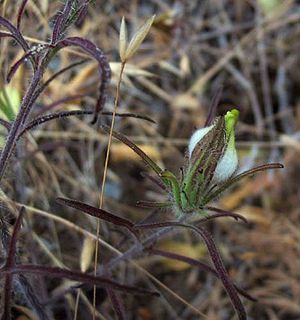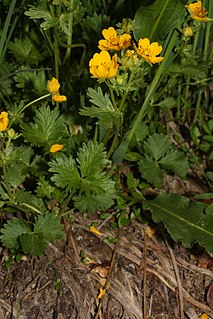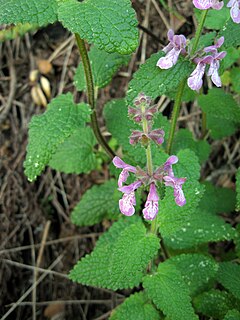
Platystemon is a monotypic genus of flowering plants in the poppy family containing the single species Platystemon californicus, which is known by the common name creamcups. It is native to Oregon, California, Arizona, Utah and Baja California, and is found in open grasslands and sandy soils below 6,000 feet (1,800 m) elevation.

Stellaria graminea is a species of flowering plant in the family Caryophyllaceae known by the common names common starwort, grass-leaved stitchwort, lesser stitchwort and grass-like starwort.

Lathyrus littoralis is a species of wild pea known by the common name silky beach pea. It is native to the coastline of western North America from British Columbia to California. It is a resident of beaches and dunes.

Cordylanthus rigidus is a species of flowering plant in the family Orobanchaceae known by the common name stiffbranch bird's beak.
Erodium brachycarpum is a species of flowering plant in the geranium family known by the common names hairy-pitted stork's-bill and shortfruit stork's bill. It is native to southern Europe but it is known elsewhere as an introduced species and often a weed, such as the west coast of the United States where it is widespread in California and Oregon.
Monardella breweri is a species of flowering plant in the mint family known by the common name Brewer's monardella.

Potentilla flabellifolia is a species of cinquefoil known by the common names high mountain cinquefoil, fanleaf cinquefoil and fan-foil.
Ribes amarum is a species of currant known by the common name bitter gooseberry. It is endemic to California, where it is known from mountains, foothills, and canyons. Its habitat includes Chaparral.
Rupertia hallii is a species of flowering plant in the legume family known by the common name Hall's California tea, or Hall's rupertia. It is endemic to California, where it is known only from a small section of the northern Sierra Nevada foothills on the border between Butte and Tehama Counties. It is a perennial herb approaching a meter in height with slender, leafy branches. The leaves are each made up of three lance-shaped or oval, pointed leaflets measuring up to 9 centimeters long. The inflorescence is a clustered raceme of several whitish or yellowish pealike flowers. Each flower has a tubular calyx of sepals and a corolla spreading to about a centimeter in width. The fruit is a hairy, gland-speckled legume around a centimeter long.

Stachys bullata is a species of flowering plant in the mint family known by the common name California hedgenettle.

Stachys chamissonis is a species of flowering plant in the mint family known by the common name coastal hedgenettle. It is a perennial herb native to the west coast of North America, where it grows in moist coastal habitat from Alaska to central California. This mint produces an erect stem 1 to 2+1⁄2 meters. It is hairy, glandular, and aromatic. The oppositely arranged leaves have pointed, wavy-edged blades up to 18 centimeters (7.1 in) long which are borne on petioles. The hairy, glandular inflorescence is made up of interrupted clusters of up to six flowers each. The flower has a deep pink tubular corolla which can be over 3 centimeters (1.2 in) long. The corollas are borne in hairy calyces of purple or purple-tinged sepals.

Stellaria calycantha is a species of flowering plant in the family Caryophyllaceae known by the common name northern starwort. It is native to western North America from Alaska and northwestern Canada to California and New Mexico, as well as eastern Russia. It occurs in subalpine and alpine climates, in many types of moist, shady habitats. It is a rhizomatous perennial herb producing a prostrate to erect stem up to 25 centimeters long, taking a clumpy form. The thin oval leaves have smooth edges and pointed tips, and measure up to 2.5 centimeters in length. The inflorescence bears one or more flowers, each on a long pedicel. Each flower has five pointed green sepals, and some flowers have up to five deeply lobed white petals.

Stellaria crispa is a species of flowering plant in the family Caryophyllaceae known by the common names curled starwort and crisp starwort. It is native to western North America from Alaska south to California and Wyoming, where it grows in moist, shady habitat such as deep forests and streambanks. It is a rhizomatous perennial herb producing a mat of prostrate or trailing stems up to about 40 centimeters long. It is lined with opposite pairs of pointed oval leaves each 1 to 2 centimeters long. Single flowers occur in the leaf axils, each borne on a short pedicel. The flower has five pointed green sepals each a few millimeters long. Some flowers have one or more petals, but most lack these.

Stellaria longifolia is a species of flowering plant in the family Caryophyllaceae known by the common name longleaf starwort. It is native to much of the northern half of the Northern Hemisphere, occurring throughout northern Europe and North America. It grows in many types of moist habitat, including meadows, marshes, and roadsides. It is a rhizomatous perennial herb forming clumps with sprawling, branching stems which are mostly hairless except for tiny rough hairs along the edges of the squarish stem. The linear to lance-shaped leaves are up to 3.5 centimeters long and are oppositely arranged in pairs. The inflorescence bears several flowers, each on a short pedicel. The flower has five pointed green sepals each a few millimeters long. There are five white petals, each so deeply lobed it appears to be two.

Stellaria longipes is a species of flowering plant in the family Caryophyllaceae known by the common names longstalk starwort and Goldie's starwort. It has a circumpolar distribution, occurring throughout the northernmost latitudes of the Northern Hemisphere. It is a perennial herb that grows in a wide variety of habitat types, including tundra and taiga and many areas farther south with subalpine and alpine climates. It is extremely variable in morphology, its form depending on both genetic makeup and environmental conditions. It has a widely varying number of chromosomes. In general, it is a rhizomatous perennial herb forming mats or clumps, or growing erect. The stems may be short and simple or with sprawling and highly branched. The linear to lance-shaped leaves are usually 1 to 4 centimeters long and are oppositely arranged in pairs. The inflorescence bears one or more flowers, each on a short pedicel. The flower has five pointed green sepals each a few millimeters long. There are five white petals each divided into two lobes, sometimes shallowly, but often so deeply there appear to be two petals. The plant is gynodioecious, with some flowers having functional male and female reproductive parts and others being only female.

Stellaria nitens is a species of flowering plant in the family Caryophyllaceae known by the common names shiny chickweed and shining starwort. It is native to western North America, including British Columbia, Alberta, and the western United States, its distribution extending into Mexico at least as far as Baja California. It grows in many types of habitat, in dry and moist areas, and sometimes in disturbed places. It is an annual herb producing a slender, upright, four-angled stem from a thin taproot, reaching up to about 25 centimeters in height. Most of the leaves are located low on the stem, each measuring up to 1.5 centimeters long, with smaller, narrower leaves occurring above. The leaves are hairless except for some rough hairs along the margins, and the blades have shiny surfaces. The inflorescence bears a few flowers on short pedicels. The flower has five pointed sepals each a few millimeters long. There are sometimes five tiny white petals as well, though these are often absent.

Stellaria obtusa is a species of flowering plant in the family Caryophyllaceae known by the common names Rocky Mountain chickweed, blunt-sepaled starwort, and obtuse starwort. It is native to western North America, from British Columbia and Alberta to California to Colorado, where it grows in moist areas in forests and on mountain slopes.
Stellaria umbellata is a species of flowering plant in the family Caryophyllaceae known by the common names umbrella starwort and umbellate starwort. It is native to western North America from Alaska and northwestern Canada to the southwestern United States, as well as parts of Asia, including Siberia. It grows in subalpine and alpine climates in mountain forests and riverbanks. It is a rhizomatous perennial herb producing a slender prostrate stem up to about 20 centimeters long, sometimes forming clumps or mats. The stem is lined with pairs of oval leaves each up to about 2 centimeters long. The inflorescence is an umbel-shaped array of several flowers each on an arching or erect pedicels. The flower has five pointed green sepals each no more than 3 millimeters long. There are occasionally tiny white petals within the calyx of sepals, but these are generally absent.

Trifolium obtusiflorum is a species of clover known by the common name clammy clover. It is native to California in the Peninsular, Transverse, Sierra Nevada, and the California Coast Ranges and Cascade Range into southwestern Oregon.

Triphysaria pusilla is a species of flowering plant in the family Orobanchaceae known by the common name dwarf owl's-clover.















